
Original Link: https://www.anandtech.com/show/1776
X-Fi and the Elite Pro: SoundBlaster's Return to Greatness
by Derek Wilson on August 30, 2005 11:59 AM EST- Posted in
- Smartphones
- Mobile
Introduction
Ever since the SoundBlaster AWE 64, we have been waiting for a Creative Labs product that lives up to the SoundBlaster legend. The bar was set very high with the pre-PCI generation of SoundBlaster products and Creative became the de facto standard in PC sound. The Live! and Audigy product lines didn't bring about the same revolution in sound for which Creative was known. Rather than advancing by leaps and bounds, the industry has slowly and steadily been creeping forward over most of the last decade.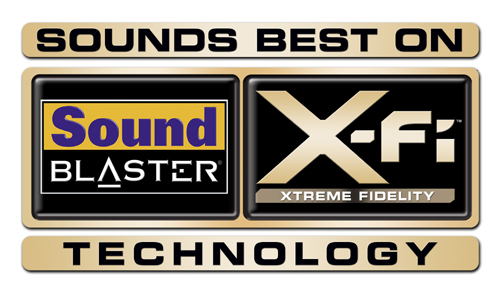
The SoundBlaster X-Fi Elite Pro is the best non-pro sound solution for audio listening, features and recording. In addition, the potential for higher quality and performance for sound in games is unique to the upper class of the X-Fi line. The downside, and our biggest concern about the product, is price and value. Is the top of the line worth the $400 premium? We hope very much that this article on X-Fi technology and the SoundBlaster X-Fi Elite Pro will answer that question.
The X-Fi Audio Ring: Powerful and Flexible
Putting aside marketing buzz words and the slightly tacky Xtreme Fidelity moniker, the new generation of sound cards from Creative Labs is quite impressive. The technological advancements come from the inclusion of four key new features: the ring based architecture, a high quality sample rate converter, a powerful DSP, and on-board RAM. First on the chopping block is the Audio Ring.
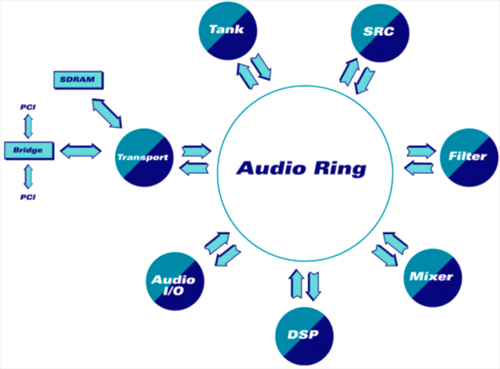
Another reason why Creative may have chosen to support so many internal channels is so that it can handle algorithms that call for splitting or duplicating an audio stream for multiple different types of processing and analysis. This could range from using CMSS-3D (Creative's new surround upmixing feature) to efficient implementations of complicated high order N-tap and feedback filters. Creative doesn't talk much about the uses of these internal channels, but many of their new features include detecting aspects of the audio being played in order to enhance the sound. It seems likely to us that the algorithms that implement their new features would rely on the high number of channels and the flexibility of the ring architecture to get as much done at one time as possible in order to keep from introducing an unacceptable amount of latency.
Now that we know how the ring works, here's what each node on the ring does:
Transport: This handles moving audio streams in and out of local RAM as well as over the PCI bus to system RAM. The Transport engine manages over 1000 DMA channels to both the PCI bus and local SDRAM. Being able to manage so many DMA requests at a time is important for dealing with the latency of PCI and effectively managing the volume of data with which the new solution is capable of working.
Tank: Its name is based on the tanks that held mercury used to create high quality analog delay lines. The tank engine is capable of fractional and modulated delay lines (delays that don't line up with the sample pattern and delays that change over time). The tank engine supports up to 1024 accesses per sample. This means that the tank engine can assist in many types of effects including: chorus, reverb, reflections, and interaural time delays (for positional audio effects). These effects are employed quite a bit in many of the audio processing features of the X-Fi, so avoiding the use of a DSP for the creation of a delay line is very helpful in spreading out processing power.
SRC: The Sample Rate Converter seamlessly transforms any audio stream or channel to any other supported sample rate with very low ripple and THD+N. We will cover this node in detail as it is one of the key features of the new architecture, allowing Creative to convert the sample rate of all audio multiple times independently of any other audio with little to no discernable loss in quality.
Filter: The filter engine implements 512 floating point 2nd order IIR filters. This is the fundamental building block of sound synthesis, 3D spatialization, equalizers, speaker calibration, and a host of other features. There are 13 filter types implemented in hardware from direct and parametric 5 parameter EQs to notch and peak filters. Complex (higher order) filtering and synthesis can be achieved by looping through the filter engine multiple times until the desire result is achieved.
Mixer: Consisting of 256 audio summers, 1024 parameter combiners, and 4096 single segment parameter rampers, the mixer is where internal audio channels come together. Parameter mixing and ramping are used to control effects combining for things like 3D audio effects in game. Instead of single segment, the parameter rampers can also support either 1536 multi segment rampers or 4 multi segment shapes (possible shapes are linear, pseudo exponential, and pseudo logarithmic).
DSP: The X-Fi Quartet DSP is so named because it supports 4 hardware threads. Each thread has access to two SIMD (single instruction, multiple data) units for easy stereo and complex math processing. NVIDIA has called a multiple SIMD processing unit MIMD (multiple instruction multiple data), but Creative has dubbed the overall architecture TIMD (Thread Interleaved Multiple Data) due to the hardware threading support alongside traditional methods. The Quartet DSP is central to many of the X-Fi features and we will cover this hardware at length as with the SRC engine.
Audio I/O: This node handles moving the final processed audio streams to output either digitally or through a DAC, and can also acquire input from each of the source options on the hardware. Audio sources in memory do not enter the path through this node, and likewise for audio written to memory (or a file). This block manages all the physical I/O ports on the X-Fi card.
Having easy access to any of these structures at any time during audio processing will greatly simplify the process and increase the complexity of operations possible on X-Fi hardware. In order to further optimize the architecture, Creative has introduced three distinct modes in X-Fi. These modes outline the basic type of path that audio streams will take through the ring. For instance, professional audio programs require very low latency audio from the sound card when recording. In order to accommodate this, the Creation mode limits the types of processing done to less complex (and faster) algorithms. Creation mode also allows synchronized audio streams for proper integration into a studio setting. These features aren't necessary when in Gaming or Entertainment modes, as the focus of these modes is on generating or heavily processing audio before input or output.
Architecting the card like this isn't useful unless the nodes on the ring are powerful enough to exploit the potential. Creative has spent quite a bit of time in making sure that this is the case. Their components are high quality and introduce as little distortion and noise as possible in order to make heavy processing of audio on a consumer sound card a reality. (Whether this is really a good thing or not is still up to the end user.) Over the next couple of sections, we will cover the most important components of the audio ring, as well as explore what is possible when all of this hardware sings in unison.
X-Fi Processing Elements: Exploring the SRC
Sample rate conversion is one of the causes of poor audio reproduction in current sound cards. So, why make such a big deal out of sample rate conversion on the X-Fi? This time, Creative has implemented an SRC that generates very low noise and distortion, and the Audio Ring allows data that doesn't require sample rate conversion to bypass the step altogether. For the conversion of a 997Hz signal from 44.1kHz to 48kHz, the SRC demonstrated -136dB THD+N and +/- 0.00025dB pass-band ripple. Creative says that this is 300 times the quality of the SRC step in previous generation SoundBlaster products. These excellent results allow data to be passed multiple times through the SRC without any significant distortion of the data, making the SRC a key part in effects processing.Pitch shifting can now easily be done on the SRC. Multitasking the sample rate conversion hardware for effects further allows creative to justify the efforts that they put into its development. One thing that Creative says can be dynamically applied to sound in realtime through the SRC is the Doppler effect. This could allow game designers, for instance, to apply a Doppler effect to all moving sound in a scene relatively easily. Sound synthesis can also use the SRC to change the pitch of a sound easily. The SRC also fits into 3D audio processing.
In pro audio applications, the SRC can be used to avoid the necessity of an external clock for syncing audio signals. Synchronized audio is still possible on X-Fi, but audio from multiple sources can be mixed with very good results using the SRC. As we have said before though, applications that do not require sample rate conversion will be able to bypass the SRC all together.
In order to create such a high quality SRC, Creative created a three-step hybrid filter. First, the sample rate is linearly increased by a factor of 2 using fairly simple math - no complex filters are needed for this step. The next stop along the way to sample rate conversion is a poly-phase FIR filter that up-samples its input to 2*(desired_sample_rate / original_sample_rate). This gives us data with a sample rate that is 4 times the desired sample rate. The final step is to reduce the sample rate by a factor of four (which is also an easy computation). Aside from increasing the quality of the sample rate conversion, increasing the sample rate to 4x the desired final rate also serves as an effective anti-imaging filter. The highest frequency that can be represented in sampled digital audio is half the sample rate (as per Nyquist). Imaging is a "ghost" of the audio signal in the range between the sample rate and half the sample rate. Assisting with anti-imaging is a by-product of the X-Fi SRC.
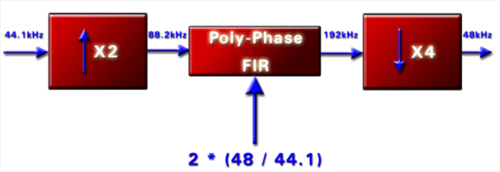
X-Fi Processing Elements: The Quartet DSP
Audio effects and processing can be done on a CPU. The latest audio solutions from Intel employ software from Sonic Focus that performs audio processing without the aid of dedicated hardware. If an end user wishes to enable advanced filtering or processing features, the Creative X-Fi has the advantage of being able to perform these tasks without tasking the CPU (thereby freeing up resources for other applications).As is often the case, a general purpose CPU is not the most efficient hardware for the job. The Quartet DSP is able to make quick and efficient work of audio data. As mentioned before, the Quartet is made up of 4 independent two-issue SIMD engines, which Creative calls a TIMD architecture for Thread Interleaved and Multiple Data. The configuration of the SIMD paths in Quartet lend themselves well to audio processing.
Creative didn't tell us how wide the data path is down each SIMD pipe, but Quartet is able to handle either integer or floating point data, making it more flexible than DSPs used on older Creative parts. Special instructions allow differing operations to be performed on SIMD data to enable more efficient audio processing. For instance, the FADDSUB2 instruction performs an add-on-one data path and a subtract on another. The DSP is also able to perform complex floating point math with the real and complex results completing in different paths.
In traditional DSP architectures, raw speed often wins out over programmability. Tradeoffs are always necessary, but the Quartet offers a good balance. The result of one instruction can be used in the next with no stalls or reordering necessary and any instruction can be performed after any other instruction without any conflict. Also, any register can be used as any operand in any instruction. While we don't have all the details on the hardware, a high level language compiler could easily target and optimize for this architecture.
At this point, an easy to develop and efficient compiler only really helps Creative write driver and feature code more easily. It could be possible for Creative to allow developers access to their compiler in order to develop specialized DSP code. We don't know if Creative will actually pursue this in the future, but the option is there should they choose to do so.
To sum up the capabilities of the Quartet DSP, we have this list of features:
- 2 SIMD units per each of 4 simultaneous threads
- fixed and floating point data supported
- 235 opcodes
- up to 1200 MIPS
- can perform up to 4 moves per instruction
- easy to compile and optimize
New Features, Possibilities, and Modes
The main new audio processing features of the X-Fi line are the 24-bit Crystallizer and CMSS-3D. These features, as well as the onboard RAM and the three modes of operation (gaming, entertainment, and creation) will be explored in this section. We know what each of these features is and the basic principles on which they operate. While we could make a much more thorough analysis of the quality of these features, if we had some actual math to go on, it is understandable that Creative would want to protect their investment by keeping the intimate details of the architecture private. What we do know should be enough to go on for now.The 24-bit Crystallizer
The 24-bit Crystallizer takes 16-bit audio and tries to add dynamic range to the audio signal. If we were to convert our 16-bit audio stream to 24-bits, we could essentially do so by adding 8 zeros to the least significant end of each sample. It becomes clear that the highest value that a sample can take on is much less than the highest value possible with 24-bit audio. Likewise, on the low end, the audio stream isn't capable of representing values between zero and 256. The basis of the 24-bit Crystallizer is to fill in these least significant bits with meaningful data and thus, expand the dynamic range of the audio. What, exactly, is meaningful data in the least significant bits? We're glad that you asked.Audio engineers are big fans of compression. Applying compression to a sound decreases the dynamic range of a sound in order to preserve the loudest and quietest parts without clipping or burying the subtleties in noise. This is very necessary to make good use of 16-bit audio, as things like whispering over a snare hit are not easily representable otherwise. Knowing the basic manner in which audio engineers go about applying effects to sounds, Creative can try to reverse-engineer the process to add more data where it seems necessary.
Details on the technique are fuzzy at best, but we do have some information. The algorithm doesn't simply expand the audio signal; it looks for recognizable patterns in frequency and time and applies algorithms that fill in the data where necessary. For instance, the X-Fi hardware is able to detect something like a kick drum hit and use the sound and proportionally weighted, transient, low-frequency data to boost the impact of the event.
The algorithms focus on the energy flux in different frequency bands in order to localize the impact of the effect. This means that things like snare and symbol hits, the plucking of strings on an acoustic guitar, the slapping of a string on a bass, and gunshots in games should all become more distinct. Each sound will be enhanced according to its energy flux, frequency, and waveform. Creative states that this can even help clean up the high end on MP3 encoded files. What this doesn't enhance quite as well are quiet subtleties in the audio signal.
CMSS-3D
For 5.1 sources played on headphones with CMSS-3D, Creative uses HRTF (Head Related Transfer Functions) to virtualize the position of each audio channel around the listener. This technique is augmented with simulated environmental reflections, which attempt to improve the externalization of sound to the listener. These environmental effects are more subtle than the Dolby Headphone effects and are meant to convey a listening environment that matches the recording rather than one that fits the room in which the listener is sitting.When enabled for 3D virtualization with two speakers, the methods used are similar to that of the headphone implementation. Rather than adding environmental reflections, this CMSS-3D mode includes a cross-talk canceller to make sure that signals from one speaker are not destructively combined with signals from the other at the listening sweet spot. Unfortunately, there is still a sweet spot for listening to audio in this mode, but settings like speaker angle are easily adjustable.
Probably the best use for CMSS-3D has nothing to do with two speaker setups. Getting the most out of a 7.1 channel audio setup is much easier with CMSS-3D. We still don't recommend using CMSS-3D for stereo sources, but for listening to 5.1 audio, CMSS-3D will do a good job of fitting the 5.1 sound to 8 channels. For creating a multi-channel environment with a two-channel source (if we absolutely must), our favorite solution is still Sonic Focus' implementation on Intel hardware. It's a shame that they won't open up their software for other hardware.
64MB onboard RAM
The top two models in the X-Fi series feature 64MB of SDRAM on the sound card itself. This feature is called X-RAM, but that isn't a technical term. X-RAM is a marketing name given to maintain the X- moniker of the card itself. This RAM is supposedly included to enhance the performance of games. Until games are written to take advantage of this feature, we will have to simply accept the possibility for performance improvement.Creative has shown us some numbers that they have run using UT2K4 and a special patch that allows for playing over 100 voices at a time (currently only 30 are supported in the game), as well as uploading uncompressed sound files to the onboard memory. The numbers show a pretty big performance improvement when X-RAM is enabled in this case. Unfortunately, we don't know how real world this test is. Without having the patch to test ourselves, we can't really know what's going on. If we are more than tripling the number of concurrent voices, we would hope to see some sort of quality improvement as well. A performance improvement for a feature that isn't necessary is a useless test.
We really need to spend more time with games that currently support X-Fi to see if we can find a case where the extra RAM affects performance. Our best guess is that we won't see real impact from this feature until developers realize that they can target the Creative solution to deliver a higher quality audio experience. Playing audio with higher sample rates, adding voices, using uncompressed audio to save CPU overhead, and freeing system RAM for other uses should be quite attractive to audio designers.
3 Modes of Operation
The final major feature is the inclusion of three distinct modes of operation. This feature is necessary because of the complexity and flexibility of the Audio Ring architecture. Tradeoffs are necessary for every type of audio application, but a configuration that can switch between modes depending on the task at hand could be a major development in the "one size fits all" audio department. These are the features of the different modes.| Gaming | Entertainment | Creation | |
| Video Game Frame-Rate: | YES | NO | NO |
| Hardware 3D Audio Processing: | YES | NO | OPTIONAL |
| Environmental Effects: | YES | OPTIONAL | OPTIONAL |
| High-Resolution Audio Playback: | NO | YES | YES |
| Audio Enhancement Processing: | NO | YES | OPTIONAL |
| 2-Channel to Multi-Channel Up-Mix: | OPTIONAL | YES | NO |
| Multi-Channel Audio Recording: | NO | NO | YES |
| Hardware MIDI Playback: | NO | OPTIONAL | YES |
| Hardware Effects: | YES | YES | OPTIONAL |
| Sample-Synchronized Record and Playback: | NO | NO | YES |
| Low Audio-Streaming Latency: | NO | NO | YES |
| Bit-Accurate Audio Capable: | NO | OPTIONAL | YES |
Professional recording requires low latency, especially when using ASIO drivers. Therefore, it makes sense that Creative would implement a mode targeted at getting audio in and out of the Audio Ring as fast as possible. Effects possible in Creation mode are limited to those that can be performed very quickly, and audio comes through the chain as unmessed as possible. Less than 2ms latencies are possible in this mode. Again, our only complaint with the Elite Pro as a professional solution is its lack of balanced I/O.
Entertainment mode focuses on the music and movie experience. Options for enhancing both stereo and surround sources are pushed to the foreground and features like the 24-bit Crystallizer and CMSS-3D will likely be heavily used in this mode.
Gaming mode is optimized for creating a multitude of hardware accelerated voices and processing them to create the best real-time 3D that audio developers can throw at it. With up to 127 3D + EAX voices, extremely complex effects are possible. Under this mode, X-RAM can be used to assist in the storage and playback of audio files.
SoundBlaster X-Fi Elite Pro
The major aspect of the SoundBlaster X-Fi Elite Pro that separates it in price from the cheaper cards in the X-Fi series is sound quality. The utmost care was taken in selecting components and building a very clean and clear sounding product. To that end, 4 Cirrus Logic CS4398 stereo 24bit / 192kHz DACs are used on the board.The CS4398 DAC is capable of 120dB dynamic range, -107dB THD+N, and even direct decode of SACD data. An NJM2114 and 3 NJM2068 dual LNAs provide good gain characteristics with very little distortion and noise. High quality components are also used in the breakout box with more Cirrus Logic components and a few Burr Brown parts. It all comes together to bring excellent sound to the listener. When we get our hands on one of the more mainstream SoundBlaster X-Fi parts, we will be able to talk better about the differences in components used and what we can expect on the quality front.
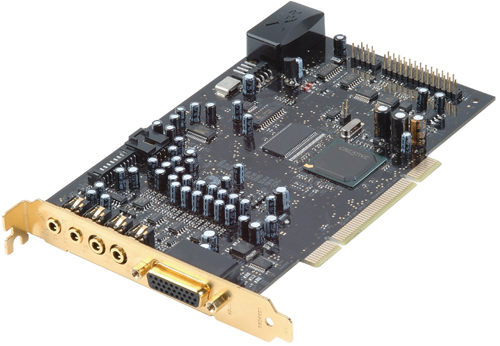
Supporting 127 hardware accelerated voices and the latest in Creative's EAX Advanced HD spec, all the features mentioned that are part of X-Fi, including one heck of a hefty price tag, make the SoundBlaster X- Fi Elite Pro. But is the latest (and greatest) from Creative worth the $400 premium? The best way to find out is to listen. And listen, we did.
Quantitative Analysis: RMAA 16-bit / 44.1 kHz
RightMark Audio Analyzer is the best tool that we have right now for determining solid numbers that describe the precision and capabilities of sound hardware in our labs. We are able to measure many of the interesting electrical characteristics of the hardware by running RMAA, which captures the output of a sound card playing a test file and analyses the recording. Unfortunately, the electrical characteristics of the recording hardware come into play when using RightMark. By using quality recording equipment, we can still get a very good idea of the hardware's capabilities. For a more in-depth look at what we are looking for in our RMAA tests, check out this page on our electrical analysis of sound hardware.The best way to see what's going on is to dive into the numbers.
| Test | Echo Audio Gina3G | SB Audigy 4 Audio | SB X-Fi Audio |
| Frequency response (from 40 Hz to 15 kHz), dB: | +0.04, -0.09 | +0.13, -0.36 | +0.01, -0.07 |
| Noise level, dB (A): | -94.3 | -94.5 | -94.7 |
| Dynamic range, dB (A): | 94.1 | 94.1 | 94.6 |
| THD, %: | 0.0057 | 0.0033 | 0.0008 |
| IMD + Noise, %: | 0.0079 | 0.0081 | 0.0054 |
| Stereo crosstalk, dB: | -94.9 | -93.3 | -97.0 |
Frequency response of the X-Fi is much better at 16-bit 44.1 kHz than the Audigy. In fact, we can see that the frequency response curve is even flatter than the Gina 3G here. The SoundBlaster X-Fi Elite Pro posts better numbers any card we've yet tested in our labs at this very heavily used bitrate.
When looking at the graphs, note that the X-Fi is able to post these numbers while maintaining consistant performance in each test. The only tradeoff we see is in stereo cross-talk, which just shows a trade off at high frequencies rather than low.
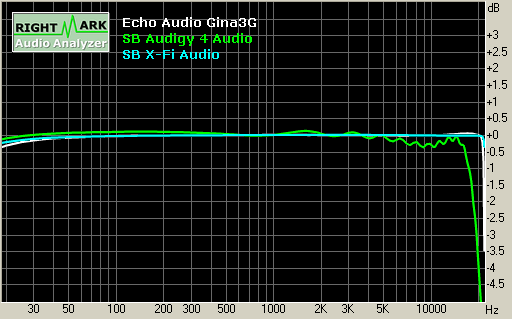
Frequency Response

Noise Level
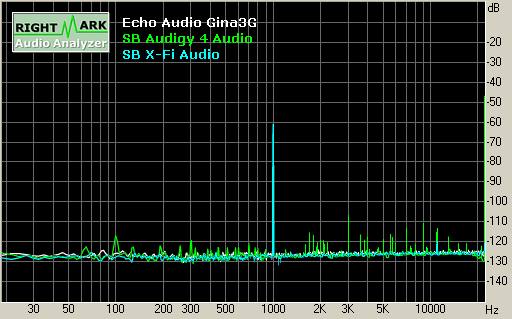
Dynamic Range

THD+N at -3dB FS
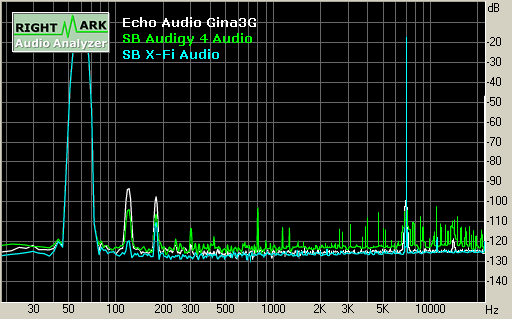
Intermodulation Distortion

Stereo Crosstalk
Quantitative Analysis: RMAA 16-bit / 48 kHz
Here we have the 16-bit 48 kHz numbers. While this is a common format, it is less important than the 44.1 kHz data. Again, we see consistently better sound quality numbers than our professional audio solution as well as the Audigy.| Test | Echo Audio Gina3G | SB Audigy 4 Audio | SB X-Fi Audio |
| Frequency response (from 40 Hz to 15 kHz), dB: | +0.03, -0.09 | +0.04, -0.11 | +0.01, -0.07 |
| Noise level, dB (A): | -92.7 | -95.8 | -95.0 |
| Dynamic range, dB (A): | 92.7 | 95.9 | 95.0 |
| THD, %: | 0.0054 | 0.0054 | 0.0008 |
| IMD + Noise, %: | 0.0084 | 0.0069 | 0.0054 |
| Stereo crosstalk, dB: | -93.6 | -94.6 | -96.5 |
To confirm the numbers and quality of the audio, take a look at the graphs for each test as well.
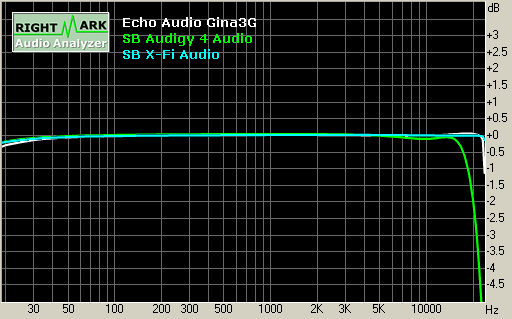
Frequency Response
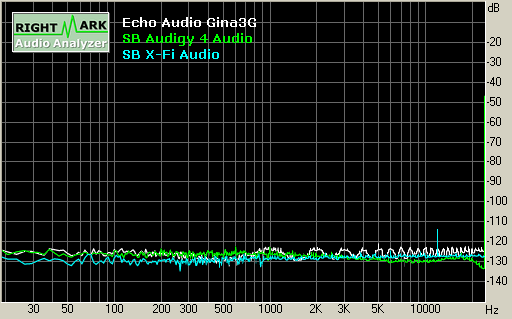
Noise Level
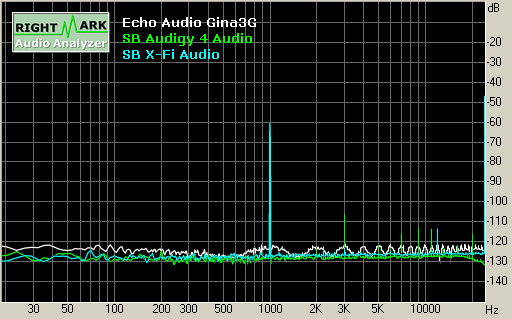
Dynamic Range
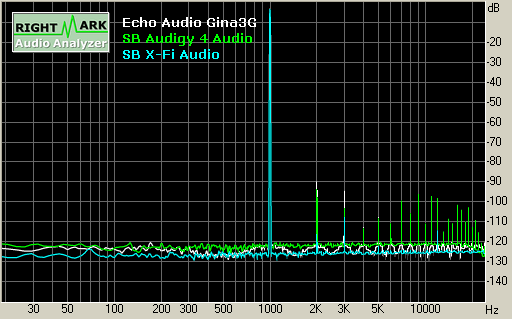
THD+N at -3dB FS
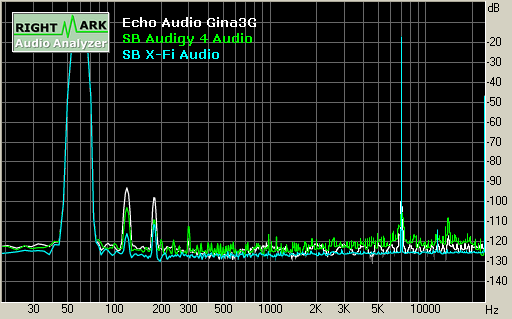
Intermodulation Distortion
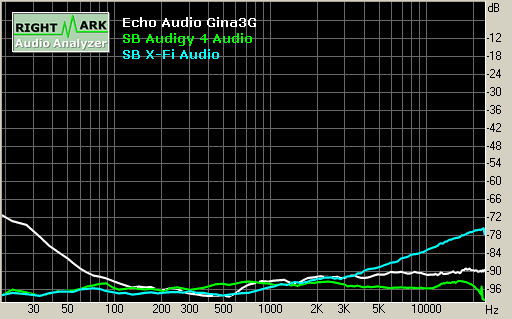
Stereo Crosstalk
Quantitative Analysis: RMAA 24-bit / 96 kHz
The highest quality test we run puts the X-Fi clearly above its competitors. These are the settings that DVD-Audio will use, and musicians will also likely record at this bitrate.| Test | Echo Audio Gina3G | SB Audigy 4 Audio [BC00] | SB X-Fi Audio |
| Frequency response (from 40 Hz to 15 kHz), dB: | +0.01, -0.10 | +0.02, -0.09 | +0.01, -0.07 |
| Noise level, dB (A): | -102.8 | -109.6 | -113.9 |
| Dynamic range, dB (A): | 102.7 | 108.9 | 113.6 |
| THD, %: | 0.0054 | 0.0019 | 0.0006 |
| IMD + Noise, %: | 0.0062 | 0.0023 | 0.0011 |
| Stereo crosstalk, dB: | -102.8 | -108.6 | -101.7 |
We do see a bit less consistency in the X-Fi graph at this setting, but even if the graph doesn't look as clean as it could, the X-Fi shows better performance than all our other cards at every step along the way.
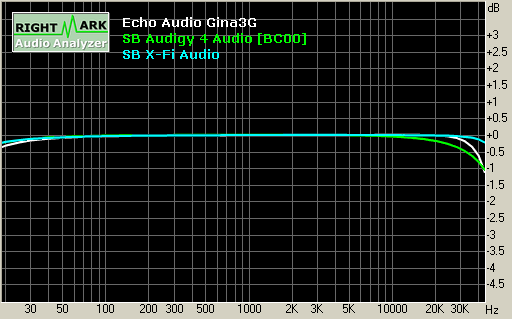
Frequency Response
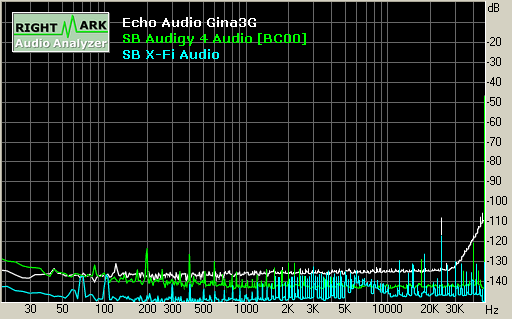
Noise Level
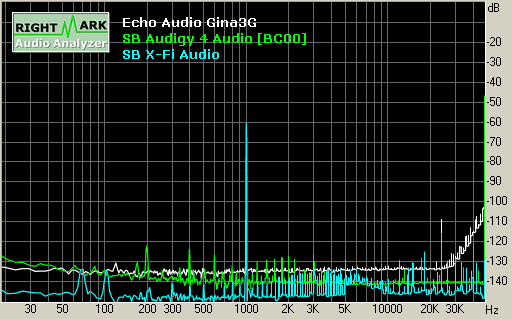
Dynamic Range

THD+N at -3dB FS
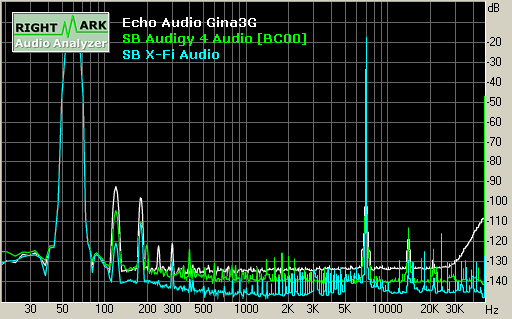
Intermodulation Distortion
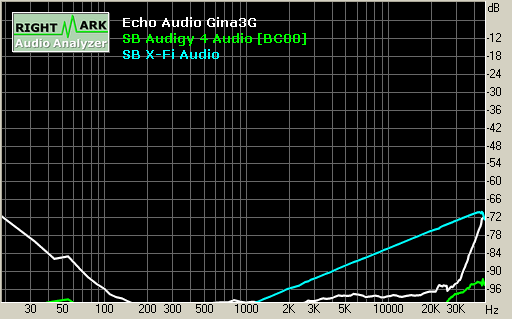
Stereo Crosstalk
Performance and Quality: Game Tests
For these tests, we will be looking at RightMark 3DSound 2.0 and Battlefield 2. With the possibility of twice the number of voices supported by Audigy, we can't do a direct comparison at some points. However, we will see how much impact going from 62 to 127 voices can have.Our test system included these components:
NVIDIA nForce 4 based motherboard
AMD Athlon 64 FX-55
1GB DDR400 2:2:2:8 RAM
NVIDIA GeForce 7800 GTX
120GB Seagate 7200.7 HD
Our RightMark tests show that the Audigy 4 Pro uses less CPU power per setting than the X-Fi. This was a little confusing at first, but we have our thoughts on why this happens. It seems to make sense to us that the X-Fi driver is more complicated than the Audigy driver. We therefore see slightly lower performance from the X-Fi card. With the X-Fi being brand new, driver improvements could also change the performance picture over time.
This performance issue should be different on the higher end X-Fi cards with games that support X-RAM. Unfortunately, we can't test this yet as no games we looked at have this ability. Storing uncompressed audio and not needing to run an MP3 or Ogg decoder in the background would help to significantly lighten the CPU load on most games. Note also how CPU usage increases nearly linearly with the number of voices used.
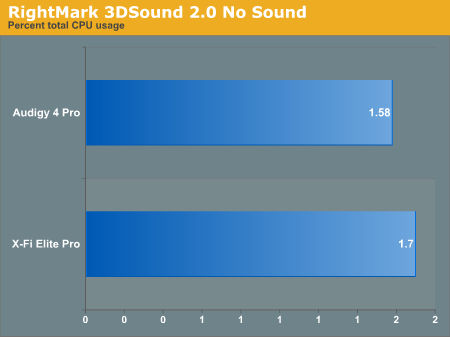
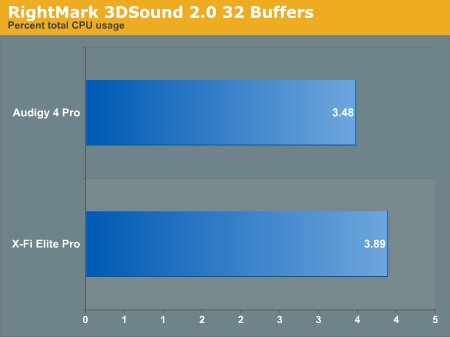
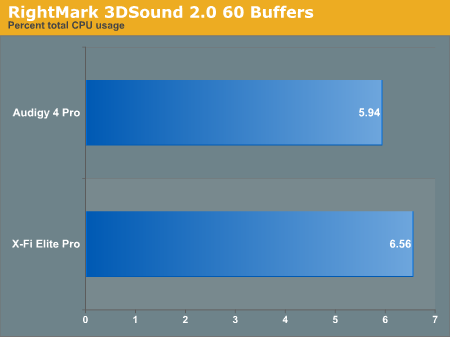
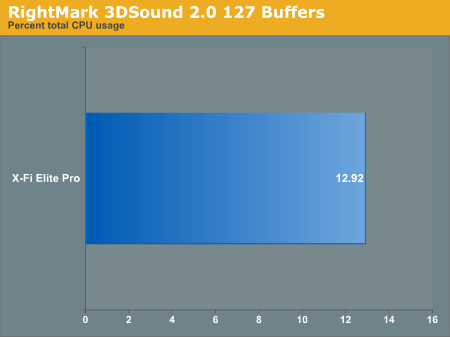
For Battlefield 2, we ran our usual test at medium quality settings at 1024x768. The Ultra High quality option in Battlefield 2 is only accessible with an X-Fi card (which likely means it employs more than 62 voices). As we can see, BF2 performance is consistent with our RightMark numbers. The X-Fi gives us just a little lower performance than the Audigy. It is nice to see that going from High Quality to Ultra High Quality on the X-Fi doesn't incur a significant performance penalty though.
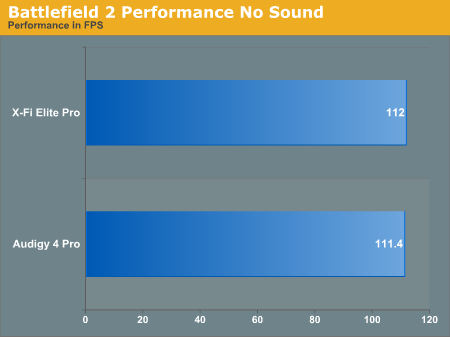
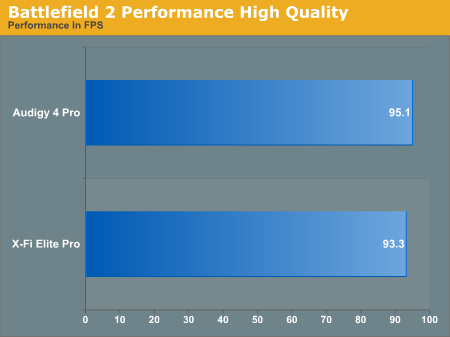
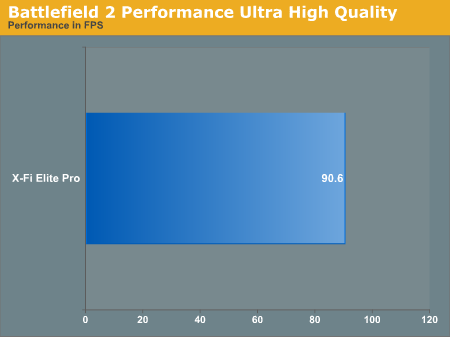
Qualitative Analysis: Audio Listening
Over the short time that we've been able to spend with the Elite Pro, we have listened to way too many sounds to talk about every single piece by name. Instead, we will talk about the general experience that we had in a particular category of listening. This way, we will be able to mention the most important aspects of a particular function without getting bogged down in describing each sound that we heard.Compressed Audio Listening: This is one of the most important categories in today's listening experience. The SB X-Fi Elite Pro is very capable of reproducing MP3, Ogg, and other types of compressed audio streams. Of course, clearly hearing the cold, metallic, distorted sound of overly compressed audio isn't as rewarding an experience as it may sound. What else is all that processing power there for if not to clean up the sound on older files? We turned on the 24-bit Crystallizer and listened for a while. In some 128kbps MP3s, the Crystallizer helped to bring out the snap, crackle and pop, and generally gave life back to the audio (especially in compressed live recordings). In other cases, the experience was overtaken by the effect with already emphasized snare or bass hits becoming almost uncomfortable to listen to (like Massive Attack's Teardrop).
16bit / 44.1kHz Listening: The CD audio experience is much better under the X-Fi Elite Pro than on earlier SoundBlaster products. It used to be that without bypassing the kernel mixer, CD audio would sound a little washed out while playing on a Creative Labs product. The foreground could sometimes get smashed into the background. We had no such experience with the X-Fi. Even our live recordings sounded like they should. When we decided to try the Crystallizer here, our experience seemed less useful than our compressed audio experience. It generally just made music sound different. Poorly mastered audio could sometimes benefit, and in many cases, we didn't care if the Crystallizer was on or off, but there were times when we would have had a better time turning it off and cranking the volume.
DVD-Audio: Crystal clear and beautiful. No need for any filtering here. Unfortunately, try as we might, it is difficult for us to hear any difference in listening to DVD-Audio on an Audigy as opposed to the X-Fi. Each card sounds as good as the source as far as our ears can tell. For lack of a 7.1 speaker system, we were unable to attempt enabling CMSS-3D for upmixing the DVD-Audio beyond 5.1 surround.
Games: Unfortunately, there are not a great many games out there that support X-Fi yet. On our list are Doom 3 and Battlefield 2. We tested both of these games and attained good results. We weren't able to create accurate and repeatable sound tests, but from our subjective analysis of gameplay, we couldn't really discern a quality difference between older hardware and the X-Fi. We will be able to judge better the qualitative use of 127 hardware channels when more games come out built around using the resources that Creative has provided to the fullest. Our experience with the MacroFX feature was less than rewarding. The MacroFX feature of CMSS-3D is supposed to account for a realistic proximity effect for near-field sources. What it did was make our guns hurt our heads while already hard-to-hear friendlies become even less audible. Yes, the feature was effective in performing its task, but at the same time, we aren't quite sold on altering the game developers intended sound.
CMSS-3D and Headphone Listening: One of the heavily talked about features of the X-Fi is supposed to be enhanced headphone listening through positional audio techniques and CMSS-3D. Even with all the advanced algorithms for downmixing 5.1 sound to a spacialized headphone mix, audio played with CMSS-3D sounded rather muddied to this listener. Despite the addition of simulated environmental reflections, frontal sounds felt as if they were located near the sides of my head above my ears. Every listener is different, so your mileage may vary. Under games, CMSS-3D seemed to be more distracting than useful. It can be interesting for a change of pace, or to add a disturbing quality to games that makes you want to squint in anticipation of firing a weapon. Some people may like it, but we prefer gaming (and all other listening) without CMSS-3D enabled. Headphone listening on the X-Fi is excellent if only because of the high quality components used in its implementation. In our opinion, the sound quality enhancements that Creative promises headphone listeners through X-Fi are a hit or miss at best.
Final Words
The final verdict is that the SoundBlaster X-Fi Elite Pro is an excellent audio solution. With plenty of analog and digital I/O, the potential for improving game performance, lots of features, and better sound quality than any other consumer sound solution on the market, the SB X-Fi Elite Pro is simply impressive. Topping the performance of the Audigy 4 Pro and the Echo Gina 3G at every bit depth and sample rate, we can't help but acknowledge the superiority of the newest top-of-the-line card from Creative.The X-Fi's SRC combined with its new Audio Ring architecture alleviate Creative's past problems with sample rate conversion and intermodulation distortion. All audio sources are played with the highest clarity and quality. Playback of 24-bit / 96kHz audio is pristine even from the back of the computer. When working with lower bitrate audio, X-Fi can apply certain filters (such as the 24-bit Crystallizer) that attempt to clean up and enhance the signal. More than twice the number of hardware voices are supported in games alongside the latest in EAX Advanced HD for 3D sound. Multi-channel works perfectly, and CMSS-3D adds some advanced algorithms for HRTF, spacialization, and multiple in, multiple out up and down mixing to support any source on any speaker configuration.
At the end of the day, we were very happy with the performance of the X-Fi Elite Pro as a sound card for gaming, as part of a pro audio chain, and as the center of an entertainment system. However, we did have some complaints. Our experience with this (and all other) hardware is that audio is best played on a speaker configuration that fits the source. Creative argues that their hardware is capable of dynamically "remastering" and "remixing" audio to best fit the system at hand. We would flat out deny this claim and are shocked that Creative would even pretend that they could provide quality on par with remastered audio. Having hardware approximated the job of an audio technician in training is something that we might be able to believe, but no amount of processing will make up for a lack of data from the source. Access to all the original tracks as they were recorded at full bitrate (or analog as the case may be) gives an audio engineer infinitely more control over the final product than Creative can have with any finalized audio. That's not to say that some assistance in fitting the source to a particular setup isn't helpful in some cases. Upmixing 5.1 audio to 7.1 comes to mind as an example of an application that makes sense.
Likewise, the 24-bit Crystallizer is not something that we would leave on (or even on one setting) all the time. It is possible for the Crystallizer to clean up, brighten up, and generally make some audio files sound "better". This is especially true in the case of over-compressed or understated audio: the Crystallizer adds a punchiness and depth to these. Of course, in cases where the transients are already fully in the foreground, enabling the Crystallizer can make already punchy audio overpowering. We understand that some dynamic range is lost on 16-bit audio, but it's not always the case that hardware can determine exactly what should fill the missing bits if the final target was 24-bit rather than 16.
We are interested in the performance advantages of the 64MB of onboard RAM. Unfortunately, we don't have many games that make use of this feature, so we aren't able to talk about the real advantages here. Creative has given us some indication that they expect some very significant quality gains in games that have very little impact on the CPU and enable developers to have more freedom in how they design audio.
The only thing that we would really like to see that we don't is Dolby Digital Live (realtime Dolby 5.1 encoding for output over SPDIF to a receiver). With all the processing power available, there is no excuse for not supporting this feature, yet we have seen no mention of it from Creative. Dolby Digital Live may not be as hot a topic as it was back when NVIDIA supported the feature in their onboard SoundStorm audio solution, but we would still like to see it added for completeness (especially when even Intel's onboard solution can handle it).
The last question that we have to address is the most important. Is the SoundBlaster X-Fi Elite Pro worth the $400 price tag? If the card is destined for a machine that will be multitasked as the centerpiece of an entertainment center, part of a gaming rig, and part of a small home studio for budding musicians, then the answer is "yes" (but only if high quality speakers and possibly a very high quality receiver and amp are to be used in conjunction with the product). The SoundBlaster X-Fi Elite Pro is not a sound card to be taken lightly, and it really deserves to be pushed to its limits.
We really can't recommend this part to the average user. Not only are the quality and feature set far beyond what a normal computer user will need, but the extremely high quality audio components used in the construction of the card are beyond what any, but audiophiles or musicians, will care about. This really is a semi-pro card packed with consumer level features and should be treated as such.
That being said, audiophiles and musicians (who don't use a balanced audio setup) will be very pleased with this card, especially if they enjoy gaming as well as just listening. We also can't wait to get our hands on other X-Fi cards. Ranging in price from $130 to $280, the rest of the new SoundBlaster line-up look to be very compelling offers. The differences between the Elite Pro and the rest of the pack include onboard RAM, the quality of the audio components used, and the I/O options included. Our guess is that most users will be quite satisfied with the SoundBlaster X-Fi XtremeMusic (the $130 card).
Creative informed us that cards should be shipping as of last week, but we still can't find them online or in stores. Even Creative's own site lists the X-Fi line up as pre-order. We will have to check into the availability of these parts as we certainly don't want the recently ATI disease ("paperlaunchitis") to spread to the rest of the computer industry.







